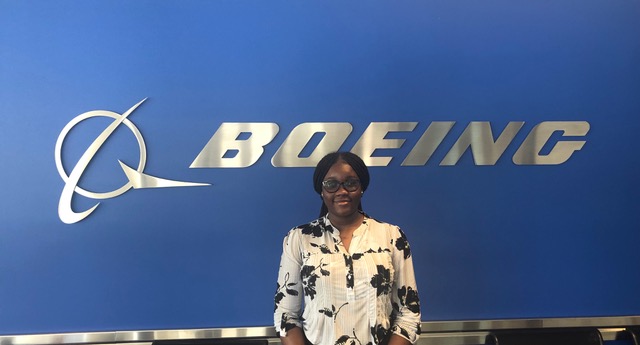
INTERNSHIP: Stress Analysis and Design Engineering of Boeing 767
Undergraduate Chinasa Onyenkpa (CEE/BME) spent her summer at the Boeing Everett Factory working as a structural engineering intern on the 767 tanker and freighter. She split her time focusing on stress analysis and design engineering.CEE: Tell us about your internship:
Chinasa: As a stress analyst, I performed ultimate and fatigue structural analysis to validate and verify structural airframe fuselage components. This ensures that they meet the Federal Aviation Administration (FAA) and Boeing’s requirements—as well as meet Boeing’s objectives. I also used Boeing analysis tools to verify the structural integrity of the 767 tanker and freighter fuselage components.Later in the internship, I switched teams and worked as a design engineer. I supported the factory work by finding new and innovative ways to improve safety, ergonomics, and quality. My work was very interdisciplinary and allowed me to interact daily with shop mechanics, manufacturing engineers, liaison engineers, design engineers, and management. There was an immense amount of on the job learning that took place because of Boeing-specific methods of analysis and problem-solving.
CEE: How did you learn about the internship?
Chinasa: I found out about this internship when I attended the National Convention for the National Society of Black Engineers (NSBE) with the CMU NSBE chapter. The convention took place in Detroit, Michigan.
CEE: Which CEE classes that prepared you for your internship?
Chinasa: My sophomore projects class helped me to develop both my problem-solving skills and knowledge of the design and production process. My statics and solid mechanics classes also prepared me very well for my role as a stress analyst.
The structural analysis methods I learned during these classes provided the foundation I needed to ensure the structural integrity of the airplane fuselage. My solid mechanics class was also particularly helpful because It introduced me to the aerospace industry.
CEE: What was the favorite part of your internship?
Chinasa: My favorite part was being able to work on such an interdisciplinary team. I got to visit the factory on a daily basis and see the planes up-close.
I also got to interact closely with the mechanics and see how planes are built and how complex the production process really is. I’m grateful that I had the opportunity to learn from engineers representing many different fields—Boeing is a very diverse company.
CEE: What advice do you have for CEE students applying for internships?
Chinasa: Take full advantage of the career fairs and career advising available to you. Don’t be afraid to network or talk to others and learn how they were chosen for internships or other opportunities. Networking and practice will help to get you one step closer to achieving your goals.